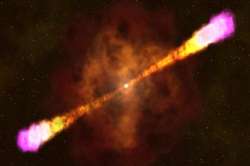Astronomers identify "nearby" star system with potential to produce gamma-ray burst
The system was nicknamed Apep. Two of Apep's stars are of the Wolf-Rayet variety meaning they are massive and reaching the end of their life.

In a second only to the Big Bang event, astronomers have identified a "nearby" star system with the potential to produce a gamma-ray burst, one of the most energetic events in the universe. According to a research published in Sydney on Tuesday, scientists revealed they have located the first of this rare star system in our galaxy, just 8,000 light years from earth, Xinhua news agency reported.
A gamma-ray burst from a star like this has the capacity to strip the earth of its Ozone layer, thankfully it was too far away, the scientists said.
"We knew immediately that we have found something quite exceptional, the luminosity across the spectrum from the radio to the infrared was off the charts," lead author Joe Callingham from the Netherlands Institute for Radio Astronomy said.
The system was nicknamed Apep. Two of Apep's stars are of the Wolf-Rayet variety meaning they are massive and reaching the end of their life.
These stars could explode into supernovae at any time and could result in a cataclysmic gamma-ray event combining with the system's extreme conditions.
"The rapid rotation puts Apep into a whole new class," co-author Benjamin Pope from New York University said.
"Normal supernovae are already extreme events but adding rotation to the mix can really throw gasoline on the fire," Benjamin said.